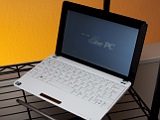
The models I look at are readily visible when one does a search at B & H Photo for a low-cost netbook.
The Acer Aspire One AOD255E is the lowest-cost netbook with the N455 processor currently available. To keep the cost down, they cut a lot of corners: Updating the memory from 1GB to 2GB is non-trivial and voids the warranty, the speaker is a single monophonic speaker, and the battery is a three-cell battery that only lasts about three hours. This model is available in four colors: Black, red, aquamarine, and brown. It is available at B & H Photo for only $240.
Costing about $10 more is the ACER Eee PC 1001PXD-EU series. Unlike the Acer, this series is only available in three colors: Black, white, and blue. Unlike the Acer AOD255E, it is simple to replace the memory in this model (note that, unlike the Lenovo S10-3 and other netbooks, replacing the hard disk is non-trivial), and stereo speakers are available.
Unlike the Aspire One (which has a glossy screen), the Eee PC uses a matte screen. The Aspire One beats out the ASUS 1001 when it comes to ports: While both models have an Analog VGA port, an Ethernet port, as well as a SD card reader, the Acer has three USB ports as well as separate 1/8" headphone and microphone jacks; the ASUS has only two USB ports and a single combined microphone/speaker 1/8" jack.
The basic low-cost model of the Eee PC 1001PXD-EU only has a three-cell battery that lasts about three hours; a six-cell battery is available for $15-20 more (depending on the model's color). The three cell version costs only $250 at B & H Photo as well as Amazon right now.
Peronsonally, I prefer the ASUS model. While it costs more and has only two USB ports, this is more than compensated for by having the memory easily upgraded to 2GB--something that is essential to have clean multitasking. Also, the matte screen should be easier to read outdoors.
A lot of people point out that the Atom N455 is underpowered. And, indeed, for some tasks like composing music, using AutoCAD, or video editing, a faster processor is desired. But, on the other hand, the N455 can happily run virtual machines, browse the web (I did have to switch from Firefox to Chrome to run Javascript-heavy pages at a decent speed), develop web applications or compiled programs using UNIX-style makefiles, edit photos to post to Facebook or what not, and run a number of applications at the same time as long as the memory is updated to 2GB.
One annoying limitation of the N455 is that it does not accept more then 2GB of memory (The AMD C-30 and C-50, however, accept up to 4GB of memory). For playing games on the web, solitaire, or other games included with Windows 7, the N455 is fine; however modern graphics-heavy 3d games are a bit heavy for this processor.
Before ending this article, I will point to a website which has excellent reviews of current netbook models: netbooklive.com. Keep in mind, however, that this writer only quotes Amazon's prices for netbooks.
The included picture is "CC BY 3.0" licensed. Attribution: Ashley Pomeroy. To post a comment about an entry, send me an email and I may or may not post your comment (with or without editing)
